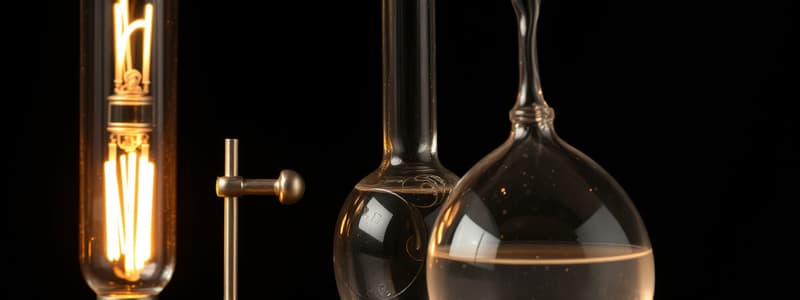Podcast
Questions and Answers
What does Boyle's Law state about the relationship between pressure and volume?
What does Boyle's Law state about the relationship between pressure and volume?
Boyle's Law states that pressure is inversely proportional to volume for a fixed mass of gas at constant temperature.
What apparatus is necessary to conduct the experiment using Boyle's Law?
What apparatus is necessary to conduct the experiment using Boyle's Law?
The necessary apparatus includes a Boyle's Law apparatus, air pump, volume scale, and pressure gauge.
During the experiment, why must you wait before taking readings after changing the pressure?
During the experiment, why must you wait before taking readings after changing the pressure?
You must wait to allow the gas temperature to return to room temperature to ensure accurate readings.
What is the significance of plotting the graph of pressure against 1/volume in this experiment?
What is the significance of plotting the graph of pressure against 1/volume in this experiment?
What is a precaution to take when reading the volume scale to avoid errors?
What is a precaution to take when reading the volume scale to avoid errors?
What role does the data logger play in the second method using a pressure gauge?
What role does the data logger play in the second method using a pressure gauge?
What should you do to ensure safety while conducting the Boyle's Law experiment?
What should you do to ensure safety while conducting the Boyle's Law experiment?
In the context of the experiment, what does the term 'reciprocal of the volume' refer to?
In the context of the experiment, what does the term 'reciprocal of the volume' refer to?
What fundamental principle does the straight line through the origin in the pressure versus 1/V graph verify?
What fundamental principle does the straight line through the origin in the pressure versus 1/V graph verify?
What is the significance of allowing the gas temperature to return to room temperature between pressure readings?
What is the significance of allowing the gas temperature to return to room temperature between pressure readings?
Explain how to avoid parallax error when reading the volume scale of the syringe.
Explain how to avoid parallax error when reading the volume scale of the syringe.
How do you calculate the weight of the metre stick using its mass?
How do you calculate the weight of the metre stick using its mass?
What should be ensured about the Newton balances during the experiment for accurate results?
What should be ensured about the Newton balances during the experiment for accurate results?
What data should be recorded when measuring forces in the upward direction?
What data should be recorded when measuring forces in the upward direction?
When balancing forces and moments in this experiment, what does the principle of moments state?
When balancing forces and moments in this experiment, what does the principle of moments state?
Why is it important to use more accurate instruments for measuring pressure and volume?
Why is it important to use more accurate instruments for measuring pressure and volume?
What is meant by the center of gravity, and how is it determined in this experiment?
What is meant by the center of gravity, and how is it determined in this experiment?
What precaution should be taken when changing the pressure in the gas chamber?
What precaution should be taken when changing the pressure in the gas chamber?
Flashcards are hidden until you start studying
Study Notes
Boyle's Law Apparatus Experiment (Method 1)
- Apparatus: Boyle’s Law apparatus, fixed mass of gas, volume scale, pressure gauge, air pump.
- Procedure:
- Set up the apparatus.
- Increase pressure using the pump to maximum value.
- Allow gas temperature to stabilize at room temperature.
- Record volume (V) from the volume scale and pressure (p) from the gauge.
- Release pressure gradually and repeat for multiple readings.
- Calculations: Compute the reciprocal of the volume (1/V).
- Data Tabulation: Organize results for pressure (p in kPa), volume (V in cm³), and reciprocal of volume (1/V in cm⁻³).
- Graphing: Plot pressure (p in kPa) against the reciprocal of volume (1/V in cm⁻³).
- Conclusion: Straight line through origin confirms Boyle’s Law; pressure is inversely proportional to volume.
- Precautions:
- Allow time after pressure change for temperature stabilization.
- Gas pressure should be released slowly to maintain constant temperature.
- Measure volume from bottom of meniscus to avoid error.
- Ensure readings are taken at eye level to prevent parallax error.
- Use more accurate instruments for measurements.
- Safety Precaution: Do not exceed apparatus pressure limits.
Pressure Gauge and Data Logger Experiment (Method 2)
- Apparatus: Gas syringe, fixed mass of gas, pressure sensor, data logger, calculator.
- Procedure:
- Open syringe to mid-volume and attach to pressure sensor setup.
- Depress plunger to increase gas pressure and hold for a minute.
- Measure trapped gas volume (V) and pressure (p) using data logger.
- Extend plunger slowly to reduce pressure and repeat for several readings.
- Calculations: Evaluate the reciprocal of volume (1/V).
- Data Tabulation: Collect pressure (p in kPa), volume (V in cm³), and reciprocal of volume (1/V in cm⁻³).
- Graphing: Create a graph of pressure (p in kPa) against 1/V (in cm⁻³).
- Conclusion: Straight line through origin validates Boyle’s Law; pressure inversely proportional to volume.
- Precautions:
- Allow readings time to stabilize post pressure change.
- Ensure temperature remains constant during the experiment.
- Avoid parallax error in volume readings.
- Utilize accurate pressure and volume measurement instruments.
- Safety Precaution: Adhere to pressure limits of the apparatus.
Centre of Gravity Experiment
- Apparatus: Metre stick, two Newton balances, retort stands, clamps, three sets of Newton weights, spirit level.
- Procedure:
- Measure and calculate mass and weight of the metre stick.
- Determine the centre of gravity by balancing the stick on a narrow fulcrum.
- Setup apparatus ensuring equilibrium is achieved.
- Use a spirit level to check horizontal position.
- Record forces from balances (F₁, F₂) and weights (W₁, W₂, W₃).
- Calculations:
- Compute sum of upward (F) and downward (W) forces.
- Calculate clockwise and anticlockwise moments about a chosen point.
- Data Tabulation: Organize measurements for upward and downward forces, and moments.
- Conclusion:
- Upward forces equal downward forces confirming equilibrium (Law 1).
- Clockwise moments equal anticlockwise moments validating rotational equilibrium (Law 2).
- Precautions:
- Ensure Newton balances are vertical to minimize friction.
- Utilize accurate measurement tools for upward forces.
- Confirm horizontal orientation of the metre stick for direct distance readings.
- Use a narrow fulcrum for precise centre of gravity determination.
- Note: Verification of laws is still valid if the metre stick is not horizontal by adjusting calculations for angle effects.
Studying That Suits You
Use AI to generate personalized quizzes and flashcards to suit your learning preferences.




